
Working-Class Americans in All States Support Progressive Economic Policies
Across U.S. states and the District of Columbia, members of the working class support policies to raise wages, increase taxes on the wealthy, and boost spending on health care, education, and infrastructure.
Media Contact
Government Affairs
Download
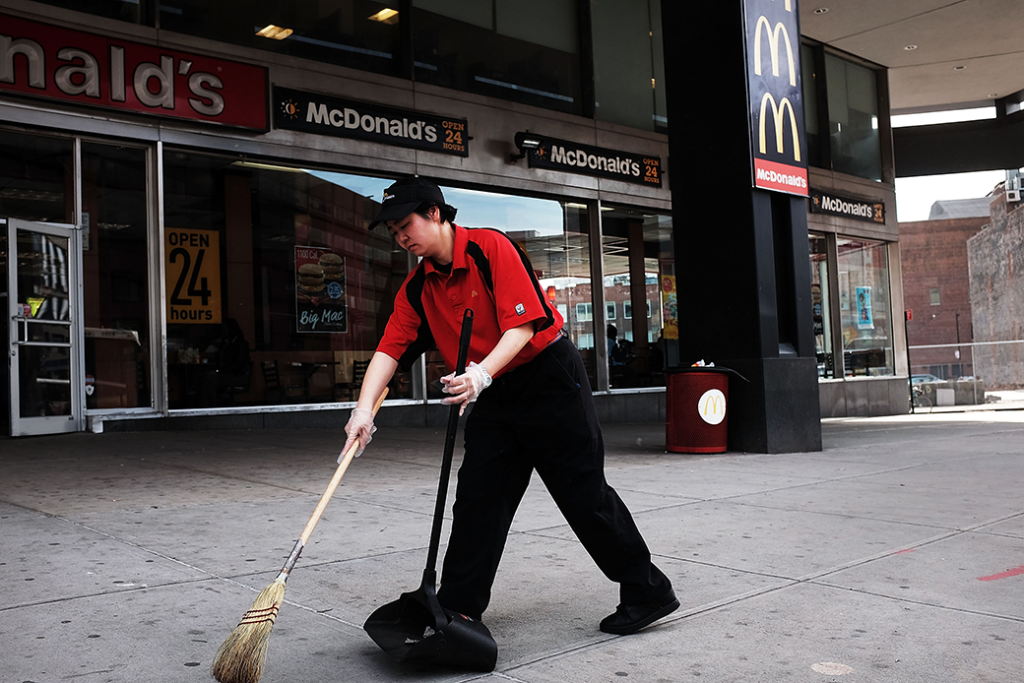
In the wake of the 2016 elections, politicians and the media have placed renewed interest on the policy preferences of so-called working-class Americans. A number of commentators interpreted the 2016 elections as a referendum by the disaffected white working class,1 spurring a focus on courting those voters. But in some cases, these narratives have relied on assumptions rather than evidence when it comes to defining the working class and identifying what types of policies are important to them. Policymakers are right to consider the policy preferences of working-class voters; just as importantly, they need to be wary of efforts that inaccurately portray the working class as racially homogenous or opposed to progressive policies.
Previous research from the Center for American Progress Action Fund showed that, like college-educated workers, working-class Americans—defined as people of all races in the workforce without a four-year college degree—overwhelmingly support a range of progressive economic policies, including those to raise the minimum wage, ensure paid leave, increase spending on health care and retirement, and increase regulation of Wall Street.2 That research also confirmed that today’s working class is racially and ethnically diverse and that white, Black, and Hispanic working-class people all support these types of progressive economic policies.
This issue brief breaks down workers’ perspectives on economic policy by state. Using data from the 2018 Cooperative Congressional Election Study (CCES),3 a nationally representative survey of 60,000 adults that provides a large enough sample for state-by-state analysis, the authors show that across the United States, members of the working class—as well as workers with additional education—support policies to raise wages, institute higher taxes on the wealthy, and increase spending on health care, education, and infrastructure.4 There are only a handful of instances in the authors’ analysis where both the working class and workers with a college education in each state did not favor progressive economic policy.5 The economic issues discussed in this brief are limited by the types of questions posed in the CCES survey and therefore are not entirely comprehensive.6 However, the responses do provide insight into what workers think about a number of current economic issues.
This issue brief does not break down state results by race and ethnicity due to sample size limitations. However, the data show that across the nation, the working class—whether white, Black, Hispanic, or Asian American—supports progressive economic policies, which is consistent with previous CAPAF research.7 (see Figure A in the Appendix) To be sure, there are certain policy questions on which attitudes of the working class diverge from those of workers with additional education8 and which workers’ attitudes are divided along racial lines.9 Still, there is strong consensus on the CCES questions that focus directly on workers’ economic interests. On most economic questions, members of the working class overwhelmingly support progressive policies, which suggests that policymakers could successfully implement these types of policies.
Today’s ‘working class’
For the purposes of this issue brief, the authors define the “working class” as members of the labor force without a four-year college degree. There is no singular definition of working class, and individuals self-identify based on a variety of factors including educational attainment, income, and occupation.10 While no classification is perfect, the authors chose to use education as the primary indicator in this study because it is more constant across people’s lifetimes.11 “College-educated workers” are defined as members of the labor force with a bachelor’s degree or higher.
Roughly 60 percent of the American labor force12 and 63 percent of the electorate13 do not have a bachelor’s degree. As previously noted, today’s working class is racially and ethnically diverse. As of 2015, 13.7 percent were African American; 20.9 percent were Hispanic;14 and nearly half were female.15 The racial and ethnic demographics of the working class also vary significantly by state. For example, in Texas, nearly 40 percent of working-class respondents in the CCES study were Black or Hispanic. In South Dakota, 98 percent were white. The fact that members of the working class held similar policy views across states suggests that the types of progressive economic policies presented in this issue brief can unite workers across race.
The types of jobs held by the working class are also different than what is commonly assumed. Until the midcentury, a significant portion of people without college degrees worked in the industrial sector or in agriculture, forestry, and fishing, though even then, a larger share of the workforce was employed in the service sector. Today, about three-quarters of the noncollege-educated labor force works in the service sector.16
Working-class Americans support raising the minimum wage
In every state, a majority of the working class supports increasing the minimum wage. (see Figure 1) Indeed, the authors’ analysis of the CCES data shows that even in supposedly conservative states such as Kentucky and Louisiana, roughly three-quarters of the working class supports raising the state minimum wage.
Working-class support for raising the minimum wage should come as no surprise, given how difficult it is for most workers to get ahead in today’s economy. Typical U.S. workers make roughly the same amount today, in real terms, as they did 40 years ago.17 Between 1979 and 2018, productivity has soared while hourly compensation has barely budged.18 This gap suggests that economic growth has not translated to higher wages for most workers. Indeed, the share of economic output accruing to workers is near historic lows.19
The minimum wage—an important mechanism for increasing worker wages—has also failed to keep up with rising costs of living. Today’s federal minimum wage of $7.25 offers far less buying power than in the past, in large part because it is not indexed to inflation.20 In 2019, the federal minimum wage was worth 31 percent less than in 1968, when its inflation-adjusted value peaked, and 17 percent less than in 2009, when the federal minimum wage was last raised.21 If the minimum wage had risen at the rate of productivity, the Economic Policy Institute estimates that today’s minimum wage would be more than $20 per hour, using 2018 dollars.22 Evidence suggests that raising the minimum wage promotes overall economic growth, and research has shown that wage growth for low-income workers has been fastest in states that increased their minimum wage.23
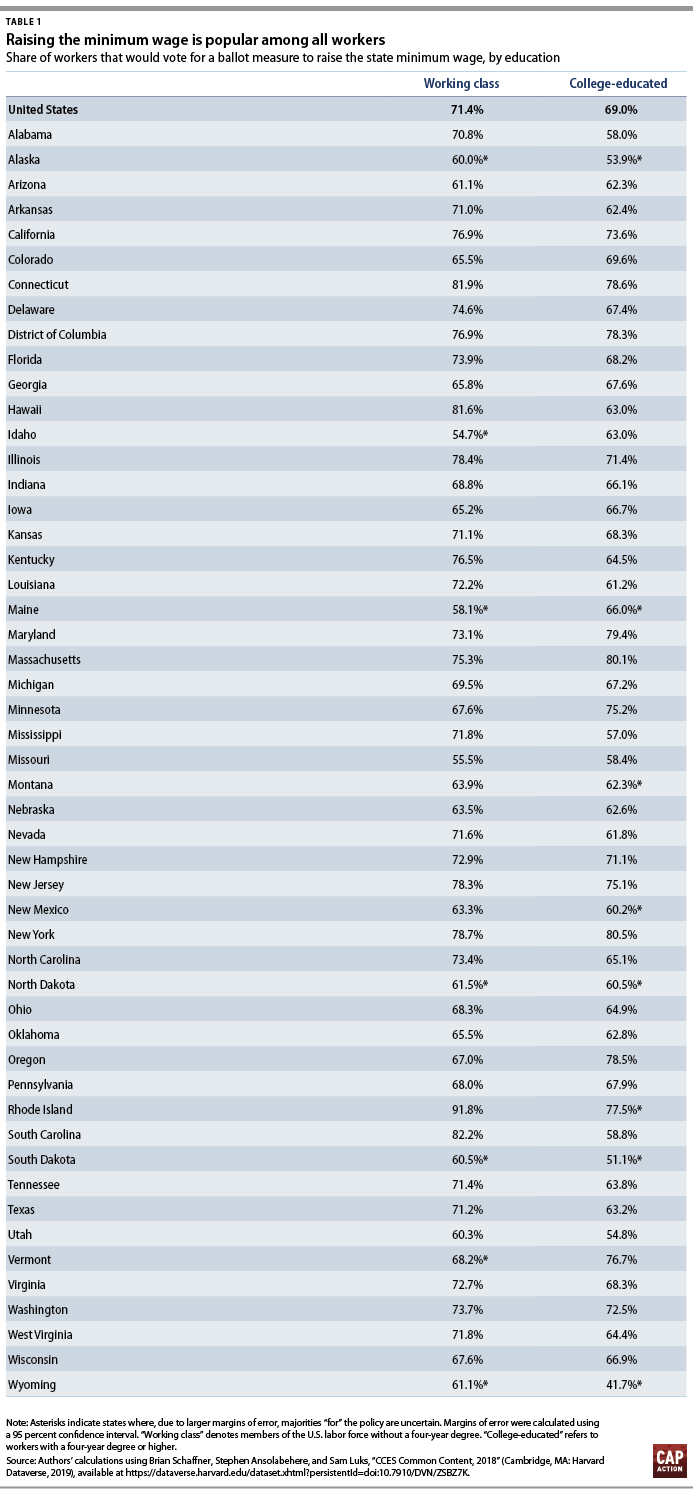
Absent federal action, 27 states and Washington, D.C., have raised their effective minimum wage since January 2014,24 including traditionally “progressive” states such as Washington and California, as well as other states such as Nevada, Missouri, and Arkansas.25 However, state action to increase the minimum wage leaves behind far too many others.26
The CCES survey asked respondents about a $12 minimum wage; however, many recent proposals have set the minimum even higher. For instance, in July 2019, the U.S. House of Representatives passed the Raise the Wage Act, which would increase the federal minimum wage to $15 by 2025 and give up to 33 million workers a raise. Furthermore, the Raise the Wage Act and many state policies eliminate the federal subminimum wage of $2.13 per hour for workers with disabilities and workers who receive tips as well as index future minimum wage increases to inflation so that workers do not lose ground each year.27 While the authors are not aware of comprehensive state-level polling data on this topic, national-level surveys have found that two-thirds of voters in surveyed congressional districts favor a $15 minimum wage.28 Taken together, these data indicate high levels of support for a higher minimum wage across states.
While the CCES survey did not ask about other policies that would raise workers’ wages, such as those that would make it easier to join a union, national-level polling suggests that pro-union policies would also be broadly popular.29
Working-class Americans support taxing the wealthy more
In addition to showing support for higher wages, the data indicate that members of the working class consistently support equitable economic policies more broadly. For example, the vast majority of the working class agrees that high-income Americans should pay higher taxes.
Income inequality in the United States is near record highs. While the middle class continues to struggle, America’s wealthiest households are taking home a larger share of national income than in recent decades and now hold an even larger share of wealth.30 More progressive tax policies that distribute income and wealth away from the very top toward programs that benefit middle- and low-income earners would help correct the imbalance of economic—and accompanying political—power.
By cutting tax rates for the wealthy and corporations, the 2017 Tax Cuts and Jobs Act (TCJA) only worsened inequality in the United States.31 Under the TCJA, the average taxpayer making more than $1 million will pay almost $70,000 less in taxes annually—more than 122 times the average tax cut received by households earning $40,000 to $50,000 per year.32 When the individual tax cuts expire in 2027, the scale will tip even further, with the top 1 percent of households receiving roughly 83 percent of tax benefits from the bill.33
According to CCES data, a majority of working-class respondents in every state except Alaska said that they would support increasing taxes by 4 percent on incomes that exceed $1 million in order to pay for schools and roads. The majority of college-educated workers in every state also support higher taxes on the wealthy. These findings point in the same direction as previous national-level CAPAF research, which found that the majority of working-class Americans favored policies that increase taxes on high-income Americans.34
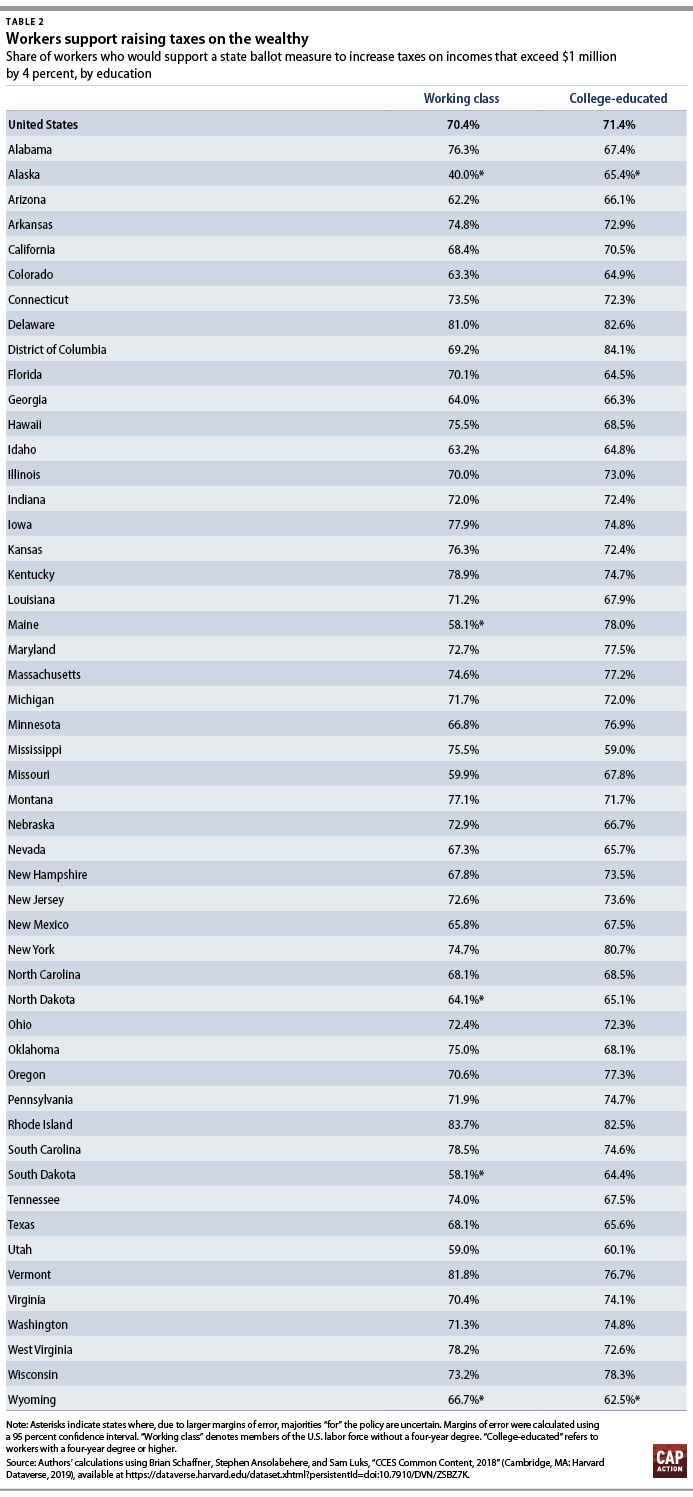
Working-class Americans support investments in health care, education, and infrastructure
In recent years, several conservative state legislatures have pushed through large budget-cutting measures at the expense of social programs.35 However, CCES data indicate that workers in every state oppose cuts to health care, education, and infrastructure spending and instead overwhelmingly support greater investments in these areas.36
According to CCES data, in all states but one—in which there was plurality support—the majority of working-class respondents support increasing spending on health care.
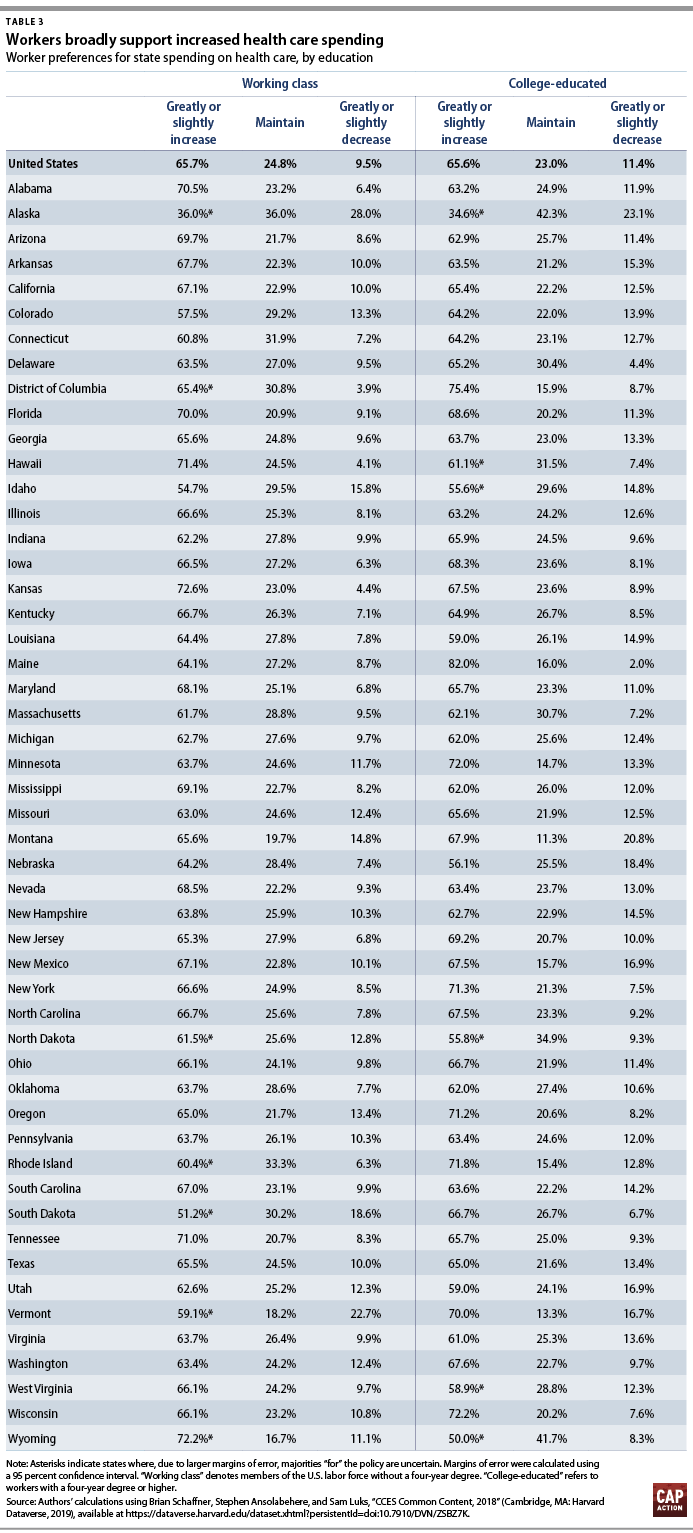
Currently, 27.5 million Americans lack health insurance.37 Despite widespread public support for universal coverage,38 conservative policymakers in many states continue to attack existing health care programs and laws that protect patients.39 As a result, the uninsured rate increased in eight states—Michigan, Washington, Ohio, Alabama, Tennessee, Arizona, Idaho, and Texas—from 2017 to 2018.40 The latest lawsuit to repeal the Affordable Care Act (ACA) could further imperil health care access41 and result in 20 million more Americans becoming uninsured.42
While several states have taken steps to combat conservative assaults on health care,43 access to health care for millions of Americans is still precarious. Nearly 2.5 million low-income people are uninsured because their states did not implement the federally funded option to expand Medicaid under the ACA,44 and other states have imposed burdensome work requirements on Medicaid beneficiaries.45 Among Americans who do have coverage, about 30 million are underinsured, meaning that they lack adequate financial protection against health care costs.46 While conservative policymakers often argue that expanding coverage is too expensive,47 the CCES data indicate that workers overwhelmingly support investing more in health care, not less.
The same is true of education. With the exception of one state, in which there is plurality support, the majority of both college-educated and noncollege-educated workers in every state and in Washington, D.C., support increasing state spending on education.
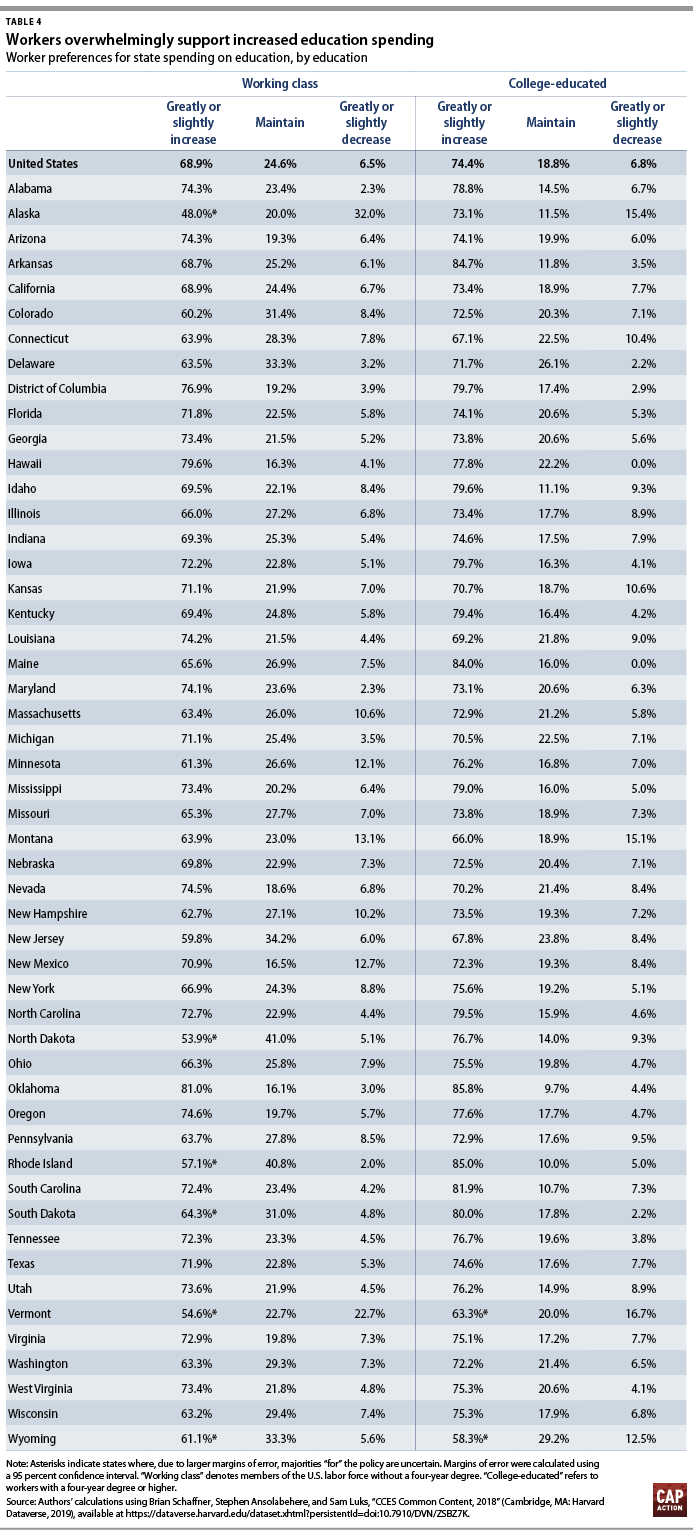
More than 90 percent of K-12 funding for education comes from the state and local levels.48 However, many states still have not recovered from steep cuts to education spending made in the wake of the 2008 recession. Making matters worse, 7 of the 12 states with the biggest cuts to education have since chosen to cut taxes, which can have further implications for state education budgets.49 In addition to state and local cuts, the Trump administration has also sought to decrease federal investments in education.50
Money matters when it comes to education. Teachers’ salaries and benefits comprise the majority of public school spending.51 Smaller education budgets force local districts to hire fewer educators or cut teacher pay. A large body of research shows that greater spending leads to higher-quality education and improved outcomes for students.52 Additionally, underfunded schools and low salaries may be causing fewer people to enter the teaching profession.53 CAPAF’s analysis of CCES data—which show overwhelming support for increased state spending on education—suggests that recent trends of educational divestment are likely unpopular among workers at all education levels.
Another area with significant spending shortfalls is infrastructure and transportation. The American Society of Civil Engineers estimates that the gap between anticipated needs and spending, accounting for all levels of government, will grow to $2 trillion over the next 10 years.54 Investments in infrastructure and transportation are essential to a well-functioning economy, because they ensure that citizens are able to live healthy lives and access jobs, essential services, and educational and social opportunities.55 In the coming decades, infrastructure spending will need to do more than maintain and repair existing structures. New telecommunications technologies will need to be deployed, particularly in rural and other underserved areas.56 Furthermore, forestalling catastrophic climate change will require rapid decarbonization and a fundamental transformation in the way U.S. transportation and infrastructure systems function.57
Luckily for policymakers, workers are united in their support for increased infrastructure spending. In every state and in Washington, D.C., the majority of workers without a college degree prefer increasing spending on transportation and infrastructure.58 And in most states, less than 10 percent of noncollege-educated workers support a decrease in spending.
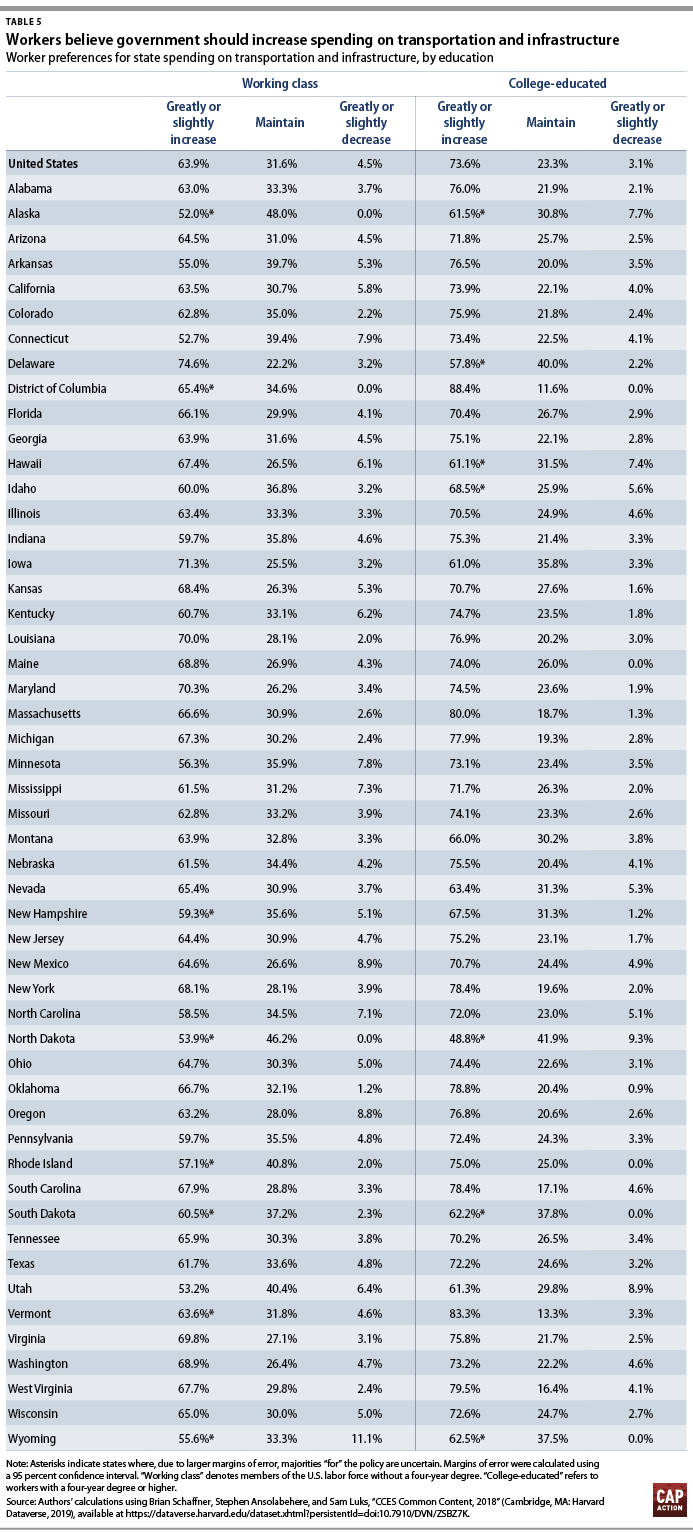
Conclusion
In an era of wage stagnation, uneven access to health care, and historic levels of inequality, many working-class families find themselves in a precarious economic situation.59 As a result, the working class is pushing for policies that will increase economic well-being and stability. CCES survey data suggest that workers across the United States—whether they have a four-year college degree or not—support policies to raise wages, institute higher taxes on the wealthy, and increase spending on basic investments such as education, health care, and infrastructure.
Not all workers support these policies, and the degree of support varies across states. Still, the data suggest that in the overwhelming majority of states, members of the working class—as well as workers with college educations—express strong support for progressive economic policies.
David Madland is a senior fellow and the senior adviser to the American Worker Project at the Center for American Progress Action Fund. Malkie Wall is a research assistant for Economic Policy at the Action Fund.
Appendix
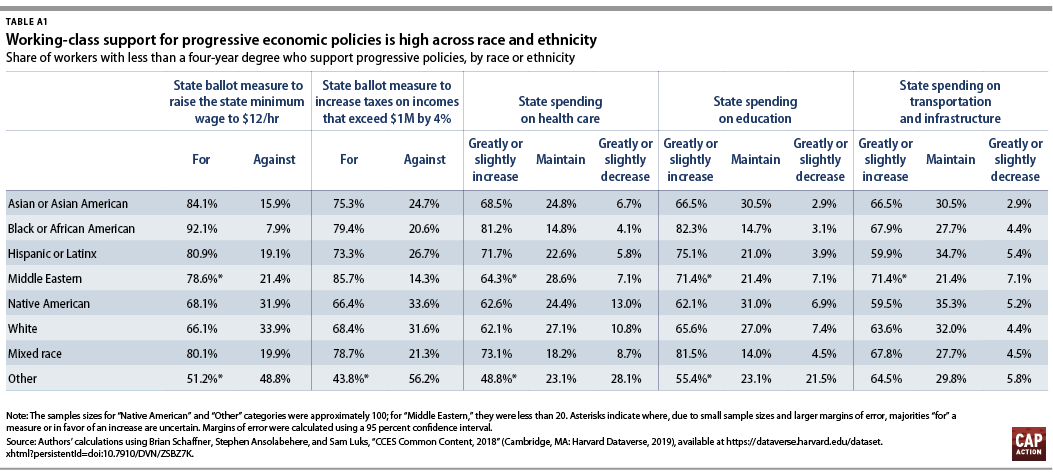
Authors’ note: CAPAF uses “Black” and “African American” interchangeably throughout many of our products. We chose to capitalize “Black” in order to reflect that we are discussing a group of people and to be consistent with the capitalization of “African American.”
Endnotes
Endnotes
- Jim Tankersley, “How Trump won: The revenge of working-class whites,” The Washington Post, November 9, 2016, available at https://www.washingtonpost.com/news/wonk/wp/2016/11/09/how-trump-won-the-revenge-of-working-class-whites/; Nate Cohn, “Why Trump Won: Working-Class Whites,” The New York Times, November 9, 2016, available at https://www.nytimes.com/2016/11/10/upshot/why-trump-won-working-class-whites.html.
- Alex Rowell and David Madland, “The Working-Class Push for Progressive Economic Policies” (Washington: Center for American Progress Action Fund, 2018), available at https://www.americanprogressaction.org/issues/economy/reports/2018/04/17/169879/working-class-push-progressive-economic-policies/.
- Brian Schaffner, Stephen Ansolabehere, and Sam Luks, “CCES Common Content, 2018” (Cambridge, MA: Harvard Dataverse, 2019), available at https://dataverse.harvard.edu/dataset.xhtml?persistentId=doi:10.7910/DVN/ZSBZ7K.
- Sample sizes for the noncollege-educated and college-educated labor forces in the least populous states are typically less than 50. Due to relatively small sample sizes in some states, there are a number of occasions where the margins of error are fairly large. Thus, the authors cannot be certain at a 95 percent confidence interval that a majority supports the policy. Such occurrences are noted in each figure. Note also that the authors’ calculations are unweighted.
- In Alaska, the majority of workers with college degrees (65.4 percent) favor increasing taxes on the wealthy, while those without college degrees are divided, with 40 percent in favor. In Wyoming, this dynamic is flipped on one question: A majority of working-class respondents (61 percent) support increasing the minimum wage, while a minority of college-educated workers (41.7 percent) do. On the question of education spending, there was a plurality of support for increased spending among working-class Alaskans but a clear majority of support among college-educated Alaskans. On the question of transportation and infrastructure spending, a plurality of both working-class and college-educated Alaskans favored increased spending. In North Dakota, a plurality of college-educated workers (48.8 percent) were in favor of increased spending on transportation and infrastructure, while a majority of workers without a college degree supported increased spending.
- Important issues such as financial regulation, corporate consolidation, trade, labor rights, and housing are not fully discussed in this issue brief.
- Rowell and Madland, “The Working-Class Push for Progressive Economic Policies.”
- For example, when asked about President Donald Trump’s executive order to ban immigrants from Iran, Somalia, Sudan, Yemen, Syria, and Libya from coming to the United States for 90 days and permanently prohibit Syrian refugees from entering the country, 54.2 percent of noncollege-educated workers in the CCES survey were supportive of the policy, while 62.9 percent of college-educated workers were opposed.
- For example, support for increased welfare spending by state legislatures is roughly 20 percentage points lower among white working-class respondents than among Black working-class respondents. Members of the white working class are also roughly twice as likely as members of the Hispanic working class to support policies to increase spending on border security by $25 billion, such as the proposal to build a wall between the United States and Mexico. Nationally, 49.8 percent of white working-class respondents supported the aforementioned border spending, compared with only 25.1 percent of Hispanic, 20.9 percent of Black, and 33.6 percent of Asian American respondents.
- Alex Rowell, “What Everyone Should Know About America’s Diverse Working Class” (Washington: Center for American Progress Action Fund, 2017), available at https://www.americanprogressaction.org/issues/economy/reports/2017/12/11/169303/everyone-know-americas-diverse-working-class/.
- This parallels the methodology used in Rowell and Madland, “The Working-Class Push for Progressive Economic Policies.”
- U.S. Bureau of Labor Statistics, “Labor Force Statistics from the Current Population Survey: Employment status of the civilian noninstitutional population 25 years and over by educational attainment, sex, race, and Hispanic or Latino ethnicity,” available at https://www.bls.gov/cps/cpsaat07.htm (last accessed October 2019).
- Pew Research Center, “For Most Trump Voters, ‘Very Warm’ Feelings for Him Endured: An examination of the 2016 electorate, based on validated voters” (Washington: 2018), available at https://www.people-press.org/2018/08/09/an-examination-of-the-2016-electorate-based-on-validated-voters/.
- Rowell, “What Everyone Should Know About America’s Diverse Working Class.”
- See Figure 2 in Ibid.
- Rowell, “What Everyone Should Know About America’s Diverse Working Class.”
- Drew Desilver, “For most U.S. workers, real wages have barely budged in decades,” Pew Research Center, August 7, 2018, available at https://www.pewresearch.org/fact-tank/2018/08/07/for-most-us-workers-real-wages-have-barely-budged-for-decades/.
- Economic Policy Institute, “The Productivity-Pay Gap,” available at https://www.epi.org/productivity-pay-gap/ (last accessed November 2019).
- See Figure 6 in Andy Green, Christian E. Weller, and Malkie Wall, “Corporate Governance and Workers: Why Today’s Economy Fails Working Families—and What To Do About It” (Washington: Center for American Progress, 2019), available at https://www.americanprogress.org/issues/economy/reports/2019/08/14/473095/corporate-governance-workers/.
- David Cooper, “Raising the federal minimum wage to $15 by 2024 would lift pay for nearly 40 million workers” (Washington: Economic Policy Institute, 2019), available at https://www.epi.org/publication/raising-the-federal-minimum-wage-to-15-by-2024-would-lift-pay-for-nearly-40-million-workers/.
- David Cooper, Elise Gould, and Ben Zipperer, “Low-wage workers are suffering from a decline in the real value of the federal minimum wage” (Washington: Economic Policy Institute, 2019), available at https://www.epi.org/publication/labor-day-2019-minimum-wage/.
- Cooper, “Raising the federal minimum wage to $15 by 2024 would lift pay for nearly 40 million workers.”
- Matthew A. Winkler, “State With High Minimum Wages Are Doing Just Fine,” Bloomberg, July 26, 2019, available at https://www.bloomberg.com/opinion/articles/2019-07-26/minimum-wage-hikes-don-t-stifle-state-economic-booms; Elise Gould, “Wage growth for low-wage workers has been strongest in states with minimum wage increases,” Economic Policy Institute, March 5, 2019, available https://www.epi.org/publication/wage-growth-for-low-wage-workers-has-been-strongest-in-states-with-minimum-wage-increases/.
- Economic Policy Institute, “Minimum Wage Tracker,” available at https://www.epi.org/minimum-wage-tracker/#/min_wage (last accessed October 2019).
- Ibid.
- There are millions of workers living in the 21 states that still use the federal $7.25 minimum wage. See Cooper, Gould, and Zipperer, “Low-wage workers are suffering from a decline in the real value of the federal minimum wage.”
- Raise the Wage Act, H.R. 582, 116th Congress, 1st sess. (January 16, 2019), available at https://www.congress.gov/bill/116th-congress/house-bill/582/text; House Committee on Education and Labor, “Raise the Wage Fact Sheet” (Washington: 2019), available at https://edlabor.house.gov/imo/media/doc/RAISE%20THE%20WAGE%20ACT%20-%20Fact%20Sheet.pdf. Several states, including Washington, Oregon, Nevada, Montana, and Alaska, have tipped minimum wages equal to the regular minimum wage, and even more states have some kind of indexing. See Economic Policy Institute, “Minimum Wage Tracker.”
- National Employment Law Project, “Poll: 2/3 Voters in ‘Battleground’ Congressional Districts Support Federal Minimum Wage of $15 by 2024,” Press release, March 28, 2019, available at https://www.nelp.org/news-releases/poll-two-thirds-voters-battleground-congressional-districts-support-raising-federal-minimum-wage/.
- A 2019 Gallup poll shows that 64 percent of Americans approve of labor unions. See Jeffrey M. Jones, “As Labor Day Turns 125, Union Approval Near 50-Year High,” Gallup, August 28, 2019, available at https://news.gallup.com/poll/265916/labor-day-turns-125-union-approval-near-year-high.aspx. Additionally, almost half of nonunionized workers said they would join a union if they could. See Thomas Kochan and others, “A growing number of Americans want to join a union,” PBS NewsHour, September 3, 2018, available at https://www.pbs.org/newshour/nation/a-growing-number-of-americans-want-to-join-a-union.
- David Madland and Malkie Wall, “The Middle Class Continues to Struggle as Union Density Remains Low,” Center for American Progress Action Fund, September 10, 2019, available at https://www.americanprogressaction.org/issues/economy/news/2019/09/10/175024/middle-class-continues-struggle-union-density-remains-low/; Emmanuel Saez, “Striking it Richer: The Evolution of Top Incomes in the United States (Updated with 2017 final estimates)” (Berkeley, CA: University of California, Berkeley, 2019), available at https://eml.berkeley.edu/~saez/saez-UStopincomes-2017.pdf; Emmanuel Saez and Gabriel Zucman, “Wealth Inequality in the United States since 1913: Evidence from Capitalized Income Tax Data,” The Quarterly Journal of Economics 131 (2) (2016): 519–578, available at https://academic.oup.com/qje/article/131/2/519/2607097.
- Chuck Marr, Brendan Duke, and Chye-Ching Huang, “New Tax Law Is Fundamentally Flawed and Will Require Basic Restructuring” (Washington: Center on Budget and Policy Priorities, 2018), available at https://www.cbpp.org/research/federal-tax/new-tax-law-is-fundamentally-flawed-and-will-require-basic-restructuring.
- Tax Policy Center, “T17-0311 – Conference Agreement: The Tax Cuts and Jobs Act; Baseline: Current Law; Distribution of Federal Tax Change by Expanded Cash Income Level, 2018,” available at https://www.taxpolicycenter.org/model-estimates/conference-agreement-tax-cuts-and-jobs-act-dec-2017/t17-0311-conference-agreement (last accessed October 2019).
- Tax Policy Center, “T17-0316 – Conference Agreement: The Tax Cuts and Jobs Act; Baseline: Current Law; Distribution of Federal Tax Change by Expanded Cash Income Percentile, 2027,” available at https://www.taxpolicycenter.org/model-estimates/conference-agreement-tax-cuts-and-jobs-act-dec-2017/t17-0316-conference-agreement (last accessed October 2019).
- Rowell and Madland, “The Working-Class Push for Progressive Economic Policies.”
- For example, see Richard Read, “Alaska is reeling from budget cuts, even as governor wants to pay each resident $3,000,” Los Angeles Times, July 19, 2019, available at https://www.latimes.com/world-nation/story/2019-07-18/alaska-budget-dunleavy; Michael Leachman, Kathleen Masterson, and Eric Figueroa, “A Punishing Decade for School Funding” (Washington: Center on Budget and Policy Priorities, 2017), available at https://www.cbpp.org/research/state-budget-and-tax/a-punishing-decade-for-school-funding; Sean Murphy, “Oklahoma plans across-the-board cuts to close budget hole,” The Seattle Times, February 15, 2018, available at https://www.seattletimes.com/nation-world/oklahoma-plans-across-the-board-cuts-to-close-budget-hole/.
- Data from the CCES show that working-class respondents in every state and Washington, D.C., support increased state investment in transportation and infrastructure and education. Note that in Alaska, on the issue of education spending, there is a plurality of working-class support. For all other questions in all other states and Washington, D.C., there is majority support.
- Edward R. Berchick, Jessica C. Barnett, and Rachel D. Upton, “Health Insurance Coverage in the United States: 2018” (Washington: U.S. Census Bureau, 2019), available at https://www.census.gov/library/publications/2019/demo/p60-267.html.
- Eighty-nine percent of Americans say that universal coverage is very important. See Kaiser Family Foundation, “Public Opinion on Single-Payer, National Health Plans, and Expanding Access to Medicare Coverage” (San Francisco: 2019), available at https://www.kff.org/slideshow/public-opinion-on-single-payer-national-health-plans-and-expanding-access-to-medicare-coverage/.
- Sam Berger and Emily Gee, “Conservatives Are Using the Courts to Attack Health Care for All Americans,” Center for American Progress, December 20, 2018, available at https://www.americanprogress.org/issues/healthcare/news/2018/12/20/464562/conservatives-using-courts-attack-health-care-americans/.
- See Figure 9 in Berchick, Barnett, and Upton, “Health Insurance Coverage in the United States.”
- Li Zhou, “The latest legal challenge to the Affordable Care Act, explained,” Vox, July 10, 2019, available at https://www.vox.com/policy-and-politics/2019/7/9/20686224/affordable-care-act-constitutional-lawsuit-fifth-circuit-court-texas-district-court.
- Linda J. Blumberg and others, “State-by-State Estimates of the Coverage and Funding Consequences of Full Repeal of the ACA” (Washington: Urban Institute, 2019), available at https://www.urban.org/sites/default/files/publication/100000/repeal_of_the_aca_by_state_2.pdf.
- Jesse Nadel, “How States Are Combating Trump’s ACA Sabotage,” Center for American Progress, August 1, 2019, available at https://www.americanprogress.org/issues/healthcare/news/2019/08/01/472615/states-combating-trumps-aca-sabotage/.
- Rachel Garfield, Kendal Orgera, and Anthony Damico, “The Coverage Gap: Uninsured Poor Adults in States that Do Not Expand Medicaid” (San Francisco: Kaiser Family Foundation, 2019), available at https://www.kff.org/medicaid/issue-brief/the-coverage-gap-uninsured-poor-adults-in-states-that-do-not-expand-medicaid/.
- Jessica Schubel, “NH Medicaid Work Requirement Suspension Confirms: Policy Can’t Be Fixed,” Center on Budget and Policy Priorities, July 9, 2019, available at https://www.cbpp.org/blog/nh-medicaid-work-requirement-suspension-confirms-policy-cant-be-fixed.
- Munira Z. Gunja and Sara R. Collins, “Who Are the Remaining Uninsured, and Why Do They Lack Coverage?: Findings from the Commonwealth Fund Biennial Health Insurance Survey, 2018” (New York: The Commonwealth Fund, 2019), available at https://www.commonwealthfund.org/publications/issue-briefs/2019/aug/who-are-remaining-uninsured-and-why-do-they-lack-coverage.
- Benjy Sarlin, “Why Medicaid Is So Hard for Republicans,” NBC News, March 10, 2017, available at https://www.nbcnews.com/politics/congress/why-medicaid-so-hard-republicans-n731491.
- Lisette Partelow and others, “Fixing Chronic Disinvestment in K-12 Schools” (Washington: Center for American Progress, 2018), available at https://www.americanprogress.org/issues/education-k-12/reports/2018/09/20/457750/fixing-chronic-disinvestment-k-12-schools/.
- Ibid.
- Ibid.
- Ibid.
- Ibid.
- Ibid.
- Kevin DeGood and others, “Building Progressive Infrastructure: How Infrastructure Investments Can Create Jobs, Strengthen Communities, and Tackle the Climate Crisis” (Washington: Center for American Progress, 2019), available at https://www.americanprogress.org/issues/economy/reports/2019/01/31/465687/building-progressive-infrastructure/.
- Ibid.
- Monica Anderson, “About a quarter of rural Americans say access to high-speed internet is a major problem,” Pew Research Center, September 10, 2018, available at https://www.pewresearch.org/fact-tank/2018/09/10/about-a-quarter-of-rural-americans-say-access-to-high-speed-internet-is-a-major-problem/.
- Ibid.
- There is one state, North Dakota, where only a plurality (48.8 percent) of college-educated voters support increased spending. (see Figure 5)
- Christian E. Weller, “Working-Class Families Are Getting Hit From All Sides” (Washington: Center for American Progress, 2018), available at https://www.americanprogress.org/issues/economy/reports/2018/07/26/453841/working-class-families-getting-hit-sides/.
The positions of American Progress, and our policy experts, are independent, and the findings and conclusions presented are those of American Progress alone. A full list of supporters is available here. American Progress would like to acknowledge the many generous supporters who make our work possible.
Authors

Malkie Wall
Research Associate


